In today’s article we look at Bainbridge Island in black and white.
Let’s start with the basics. A black and white photograph is an image where all color has been removed. Consequently, it only consists of shades of gray tone ranging from dark (i.e., black) to light (i.e., white). Some photography instructors recommend that beginners start by only shooting in black and white. The rationale is that because color is so powerful, it tends to dominate photos – so much so that beginners struggle to see other key elements like contrast, texture, shape, form, and quality of light. This makes perfect sense to me. In the photographic world, however, black and white is an art form unto itself. If you’ve ever seen one of famed photographer Ansel Adams’ landscapes from Yosemite Valley or the Sierra Nevada, you know firsthand how black and white imagery can be extremely powerful and isn’t just a learning tool for novices.
Way back when, the only way to work in black and white was to use black and white film (which, by the way, is still commercially available). With the advent of digital photography, however, it’s a piece of cake. That’s a good thing because since we’re so used to seeing the world in nothing but full color, it can be difficult to understand how those colors translate into shades of gray.
There are two options. First, you can switch your camera to its Monochrome mode, which will allow you to see the preview on your LCD display in black and white. This will give you immediate feedback on how colors translate into shades of grey. As a fellow photographer once said, “It’s hard to get your brain to know that a really bright red is going to come out pretty much the same as that deep blue in your final image.” For those who mostly use only their iPhone cameras but want to know more about black and white photography, here’s a fun exercise: after taking your photo, click on edit and change the saturation setting to minus 100, which will remove all color, and then play around with other settings like black point, contrast, and highlights.
The other method for working in black and white – and the one I employ – is to shoot in color and later convert your photos to black and white in Lightroom, Photoshop, or some other post-processing program. Nowadays, the technology – and the control one has over the final product – is simply stunning.
So let’s see what you think about our gorgeous little island when viewed in monochrome!
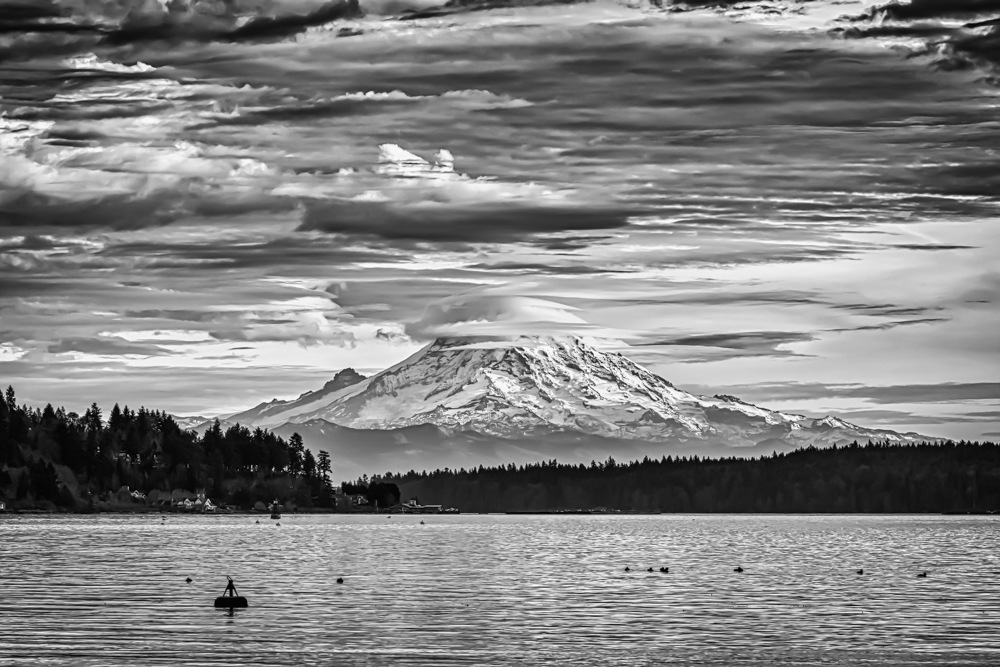
Mount Rainier is one of the most recognizable icons in the Pacific Northwest. With an elevation of 14,417 feet, it’s only 88 feet shorter than Mount Whitney, California, which is the tallest summit in the continental United States. (Sandwiched in between are three peaks in Colorado in the Rocky Mountains.) Unfortunately, the mountain doesn’t always bless us with an appearance. According to one informal study that I found on the internet, Mount Rainier was visible only 83 times in 2012 when viewed at 3:00 p.m. from Kerry Park in Seattle, or roughly once every four to five days. When I’m curious about whether the peak is gracing us with its presence, I check out this website – https://ismtrainierout.com/ – which shows the southerly view from the webcam on top of the Space Needle. I actually check it quite frequently, and while the exact time of year is a big factor, I would say the “every four to five days” estimate isn’t too far off.
The above image was taken from the beach next to Point White Drive near Lynwood Center in the southwest portion of the island. It’s one of my favorite go-to spots when I’m in the mood for photographing a certain peak. As the crow flies, Bainbridge Island is a decent distance – approximately 64 miles – from Mount Rainier National Park. This shot is a good testament to how massive the peak looks on a day with clear visibility, and it also shows how a mid-range telephoto lens can really compress distance and bring things much closer.
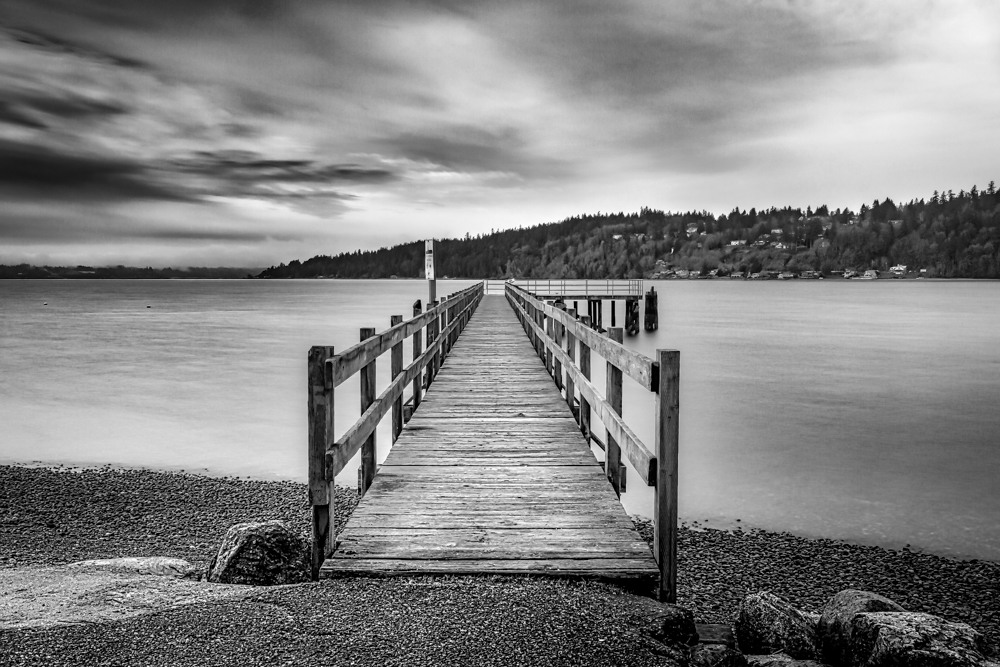
I suspect many if not most locals will immediately recognize that the above image depicts the Point White Dock off Crystal Springs Road on the southwestern side of Bainbridge Island. This is a good example of how an interesting image can be captured – maybe salvaged would be a better word? – where the shooting conditions are less than optimal. To compensate for some drab weather which I didn’t anticipate (and will blame on a faulty weather forecast), I used a long, 30-second exposure to create the smooth water surface and the dreamy look of the slow-moving clouds. To hopefully add yet more drama, I then converted it to black and white in my digital darkroom. As for the name, I picked “Anonymous Dock” because my goal was to accomplish an “abstracty” look of a dock that might be found anywhere.
Interestingly, in doing some quick online research, I discovered that our local park district refers to this location as the Point White Pier, which was a completely new one on me. I also learned that the 100-foot-long dock was used in the early-to-mid 20th century by the Mosquito Fleet, a small armada of steamships that provided the main means of transportation on Puget Sound, and that it also served as a ferry dock from 1942-1950. My solid hunch, though, is that those ferries were nothing like the super jumbo ferries now plying the waves between Seattle and Bainbridge Island.
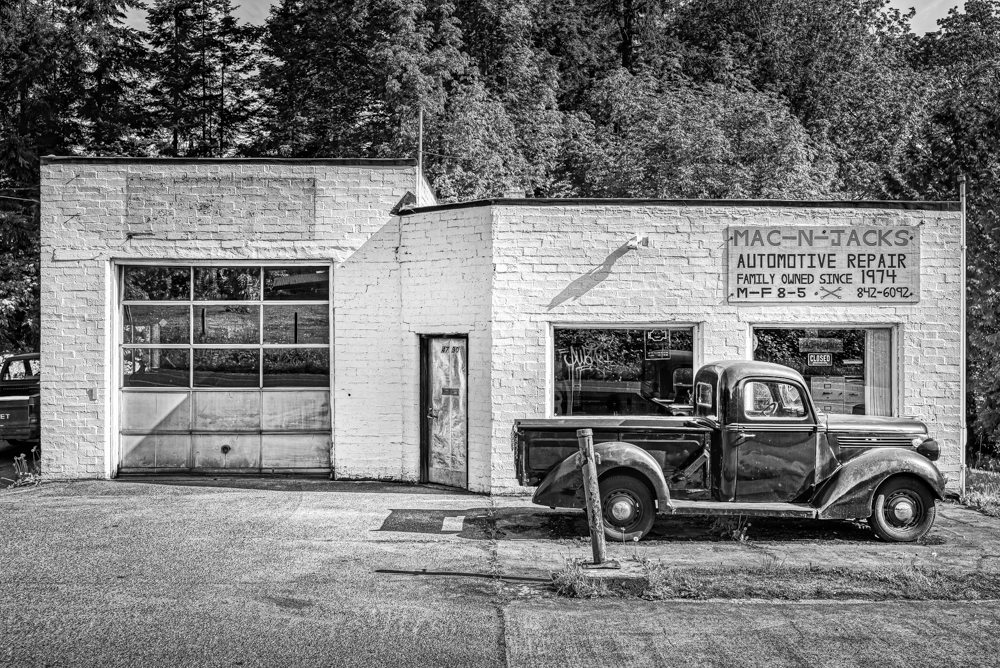
There are many institutions on Bainbridge Island, and the list would have to include Mac-N-Jacks, an automotive repair and detailing shop located in the Eagledale section of Bainbridge Island that was founded in 1974 by two brothers-in-law. Almost 50 years later, it remains a family enterprise now in its second generation of ownership. For more history of the business, click here.
Since my wife Carol and I live just a few miles from Mac-N-Jacks, I’ve driven by it countless times and often thought to myself how it was the perfect subject matter for black and white photography. I finally got off my duff in May 2019 to grab the shot in the early morning when the sun was still low and creating shadows. It’s a perfect example of how black and white can really emphasize contrast, texture, shape, form, and quality of light.
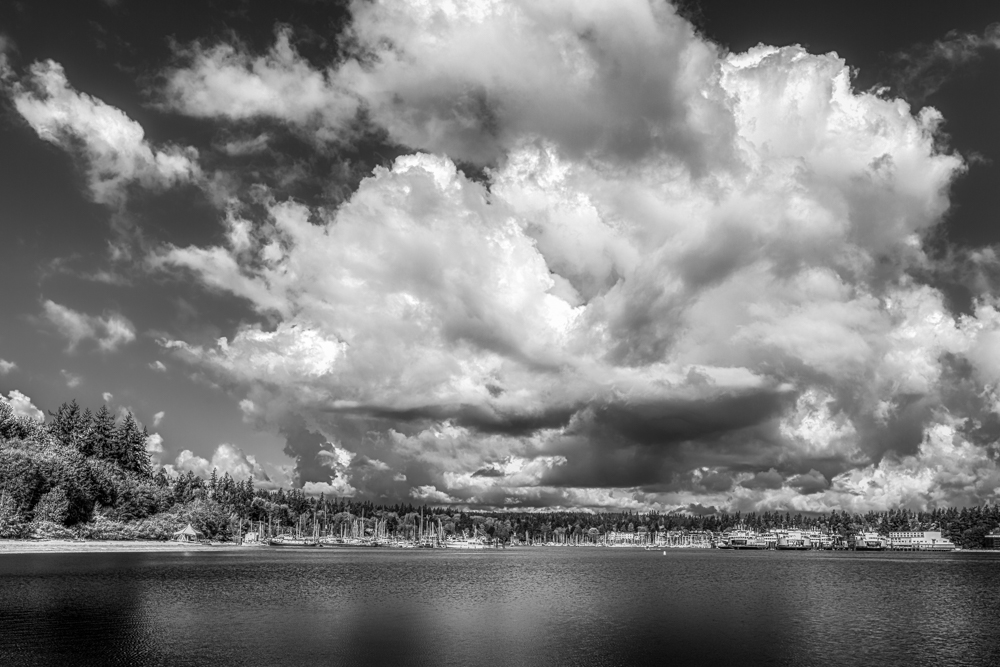
If this image looks at all familiar, it might be because the color version appeared in one of my earlier articles featuring images of clouds. (To compare, click here.) The shot was taken from Pritchard Park just west of the old Creosote Plant on a day when I was in a cloud-hunting mood – and I think it can safely be said I was extremely lucky that morning. Instead of a telephoto lens, I used my wide angle lens to capture as much of these amazing clouds as I could. This, too, is a wonderful example of how black and white can really enhance contrast in the right circumstances. In the color version, the contrast between the blue sky and white clouds is pleasing but not nearly as stark and dramatic as in the black and white image. This same statement also applies to the contrast between the shadows and reflections in Eagle Harbor in the foreground. But which version – color or black and white – is “better”? We have now entered the subjective world where there is no right or wrong answer.
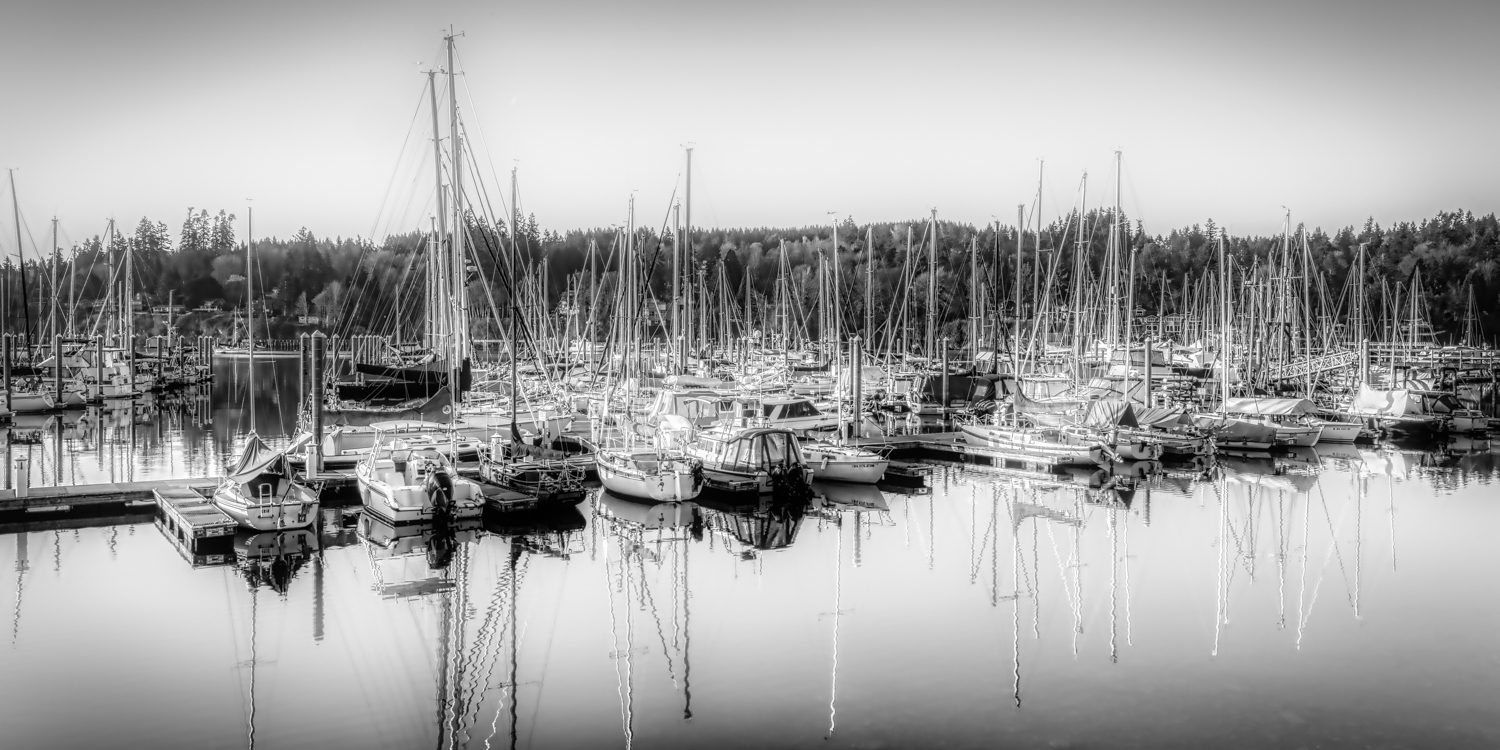
I’ve mentioned in an earlier article how I’m no fan of sunny blue skies, which should be expected from a cloudaholic like me. Moreover, when it comes to photography, sunny blue skies are the functional equivalent of grey overcast – in my view, there just isn’t much you can do with either one of them when shooting in color. On the other hand, all is not lost! When there is nothing but blue in the sky, I immediately start thinking about black and white possibilities. Depending on the tonal values in the rest of the composition, the potential for stark and dramatic contrast may exist. The above image of a portion of the Eagle Harbor marina was shot near the rear of The Pegasus Building, one of our local island classics. (Trivia time: the ivy-covered structure was originally built in 1937 for the Anderson Hardware Store and has been the Pegasus Coffee Company’s flagship location since 1980.) It’s a great example of how just like their color counterparts, a vivid black and white image can also have that “pop” factor. Thanks to the monochrome treatment, the reflections and myriad masts and lines of all the boats in the image really stand out in sharp detail.
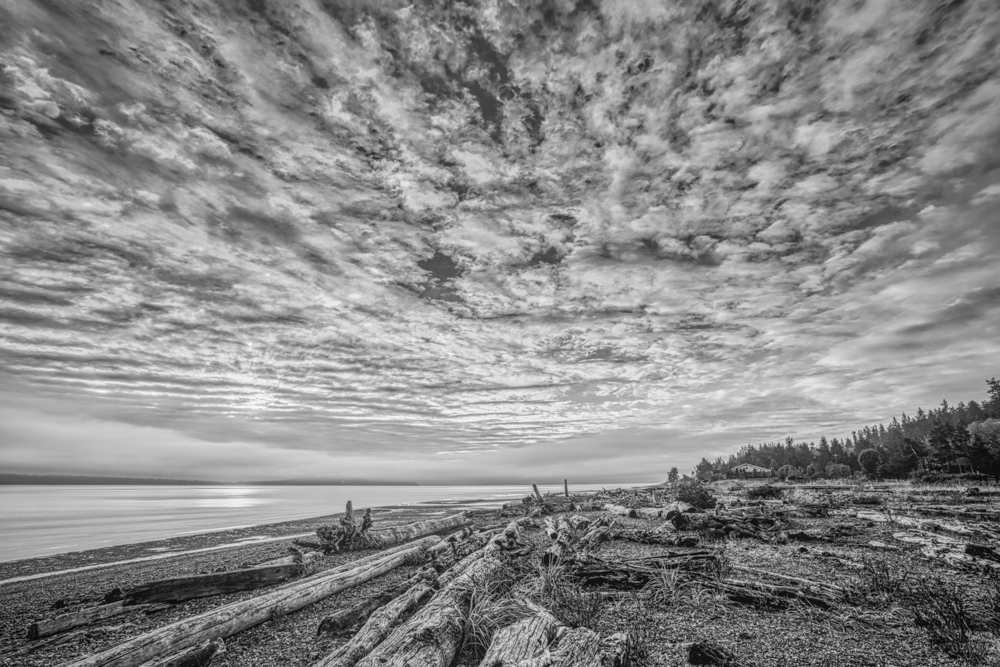
Fay Bainbridge Park is one of the gems of our local park district, and a haven for campers, tourists, and island residents alike. Where else can you enjoy 1,420 feet of no-bank saltwater shoreline with sandy beaches and sweeping views of Puget Sound and the Cascade Mountains, with occasional sightings on clear days of Mount Rainier and Mount Baker? Though my two kids long ago flew the coop, I certainly attended my fair share of family and social outings at Fay Bainbridge Park while they were still growing up. Nowadays, my visits are much less frequent because Carol and I enjoy the views and setting at Pritchard Park, which is just five minutes from our home. But for photography purposes, the peace, solitude and expansive views which Fay Bainbridge Park offers at sunrise are hard to beat.
Bergh Images
Facebook – Instagram – Website
NEXT MONTH: We are almost – but not quite yet – due for a pictorial detour away from Bainbridge Island. August, perhaps? As for next month, the choices include sunsets, foggy mornings, and sailboats. Please stay tuned!
PREVIOUS ARTICLES:
Island Images Volume #4
Island Images Volume #3
Island Images Volume #2
Island Images with Andrew (“Andy”) Bergh

ABOUT ANDREW BERGH: Local artist Andrew (“Andy”) Bergh is a long-time Bainbridge Islander (33+ years), whose successful transition from law to photography began in 2010. After displaying his unique and evocative images at different venues, including the Bainbridge Island Studio Tours, the Saturday Farmers Market, and various local businesses, Andy took the big plunge in September 2018 when he opened his own gallery – Bergh Images – in downtown Winslow. His prints are offered in different mediums, including metal, canvas, and fine art acrylic prints; matted prints; and custom-framed black and white prints. Andy has an online presence at https://berghimages.com/, which also features his entertaining travel blog. The gallery is open every day but Monday, with Andy and his wife Carol regularly participating in the monthly First Friday Art Walks sponsored by the Bainbridge Island Downtown Association.
Facebook – Instagram – Website